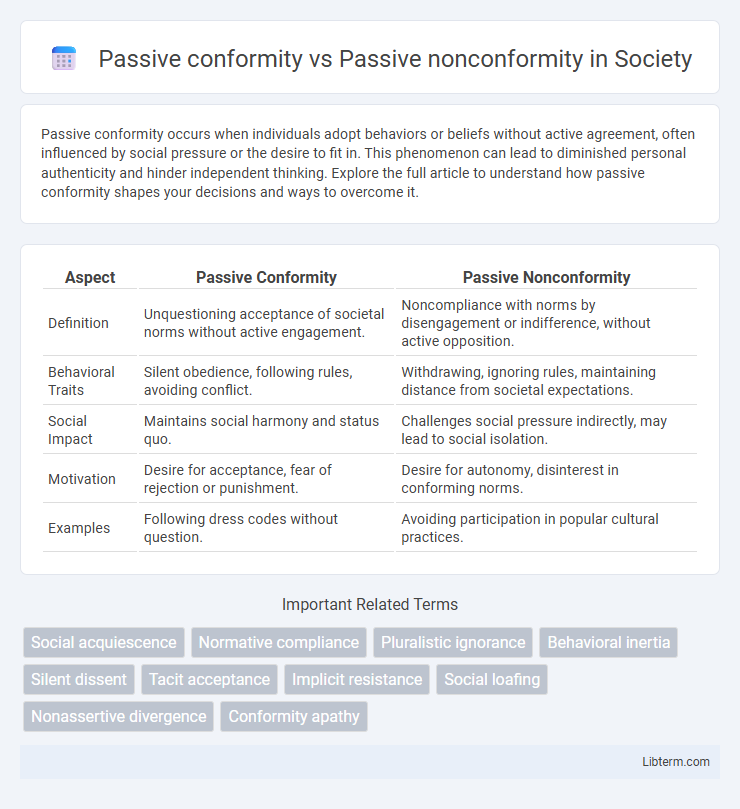Passive conformity occurs when individuals adopt behaviors or beliefs without active agreement, often influenced by social pressure or the desire to fit in. This phenomenon can lead to diminished personal authenticity and hinder independent thinking. Explore the full article to understand how passive conformity shapes your decisions and ways to overcome it.
Table of Comparison
| Aspect | Passive Conformity | Passive Nonconformity |
|---|---|---|
| Definition | Unquestioning acceptance of societal norms without active engagement. | Noncompliance with norms by disengagement or indifference, without active opposition. |
| Behavioral Traits | Silent obedience, following rules, avoiding conflict. | Withdrawing, ignoring rules, maintaining distance from societal expectations. |
| Social Impact | Maintains social harmony and status quo. | Challenges social pressure indirectly, may lead to social isolation. |
| Motivation | Desire for acceptance, fear of rejection or punishment. | Desire for autonomy, disinterest in conforming norms. |
| Examples | Following dress codes without question. | Avoiding participation in popular cultural practices. |
Introduction to Passive Conformity and Passive Nonconformity
Passive conformity involves individuals subtly aligning their behaviors, beliefs, or attitudes with group norms without overt pressure or active participation, often driven by a desire for social acceptance or fear of rejection. Passive nonconformity, in contrast, reflects a quiet or implicit resistance to group expectations, where individuals maintain personal beliefs or behaviors without openly challenging the group, often to preserve individual identity while avoiding conflict. Understanding these concepts highlights how social influence operates below the surface, shaping group dynamics through subtle compliance or discreet dissent.
Defining Passive Conformity: Characteristics and Behaviors
Passive conformity is characterized by individuals who adhere to group norms and expectations without active engagement or assertive participation, often suppressing personal opinions to maintain social harmony. Behaviors include silent agreement, compliance without enthusiasm, and minimal resistance to social pressure, reflecting an internal acceptance rather than critical evaluation. This contrasts with passive nonconformity, where individuals subtly resist or ignore social norms without overt defiance or active dissent.
Understanding Passive Nonconformity: Key Traits and Examples
Passive nonconformity is characterized by individuals who silently resist social norms without overt rebellion, often through subtle behaviors and attitudes that diverge from mainstream expectations. Key traits include nonparticipation in popular trends, avoidance of social pressures, and maintaining personal beliefs without seeking approval or attention. Examples include quietly dressing differently from peers, refraining from popular social activities, or holding unconventional viewpoints without vocal confrontation.
Psychological Roots of Passive Conformity
Passive conformity often stems from psychological roots such as the need for social acceptance and fear of rejection, leading individuals to align their behavior with group norms without overt resistance. This form of conformity is driven by internalized social pressures and the desire to maintain harmony, minimizing cognitive dissonance. In contrast, passive nonconformity involves subtle resistance or disengagement without direct confrontation, rooted in a psychological preference for autonomy and self-expression while avoiding social conflict.
Motivations Behind Passive Nonconformity
Passive nonconformity stems from intrinsic motivations such as personal values, a desire for individuality, or resistance to social norms without overt opposition. Individuals displaying passive nonconformity often prioritize internal coherence and authenticity over external validation. This contrasts with passive conformity, where adherence to group norms occurs mainly due to social pressure or a desire for acceptance rather than genuine conviction.
Social Influences on Passive Behavioral Patterns
Passive conformity involves individuals subtly aligning their behaviors or attitudes with group norms without overt resistance, often driven by social approval desires and fear of rejection. Passive nonconformity reflects a quiet disregard for prevailing social pressures, manifesting as inconspicuous deviance or neglect to participate in normative behaviors, influenced by personal values or skepticism toward group consensus. Social influences such as peer pressure, cultural expectations, and implicit group standards critically shape these passive behavioral patterns by triggering internal motivations to either assimilate or discreetly dissent.
Benefits and Drawbacks of Passive Conformity
Passive conformity involves subtly aligning with group norms without active participation, offering benefits such as social acceptance and reduced conflict. It provides a low-risk way to maintain harmony and avoid confrontation but may lead to a loss of personal identity and diminished creativity. The drawback lies in potential suppression of individuality and missed opportunities for innovation, which can hinder personal growth and critical thinking.
Advantages and Challenges of Passive Nonconformity
Passive nonconformity allows individuals to express personal values and beliefs without direct confrontation, promoting authenticity and fostering creative problem-solving within groups. This approach minimizes social friction and resistance by subtly diverging from norms, yet it may result in ambiguous communication and reduced influence on collective decisions. Challenges include potential misinterpretation of intentions and limited visibility, which can undermine the impact of passive nonconformity in driving meaningful change.
Impact of Passive Behaviors on Group Dynamics
Passive conformity often stabilizes group dynamics by promoting cohesion and minimizing conflict through unspoken agreement, which can streamline decision-making processes. In contrast, passive nonconformity subtly challenges group norms without open confrontation, potentially fostering critical reflection and innovation within the group. Both behaviors impact the group's adaptability and collective problem-solving by either reinforcing existing structures or quietly encouraging alternative perspectives.
Fostering Awareness: Balancing Conformity and Nonconformity
Fostering awareness in passive conformity involves recognizing how individuals subtly align their behaviors with group norms without active resistance, promoting social cohesion and shared values. In contrast, passive nonconformity encompasses quietly withholding agreement or participation, signaling dissent while avoiding direct confrontation, which can encourage critical reflection and innovation. Balancing these dynamics requires cultivating environments where conscious acknowledgment of conformity and nonconformity supports personal authenticity alongside group harmony.
Passive conformity Infographic

 libterm.com
libterm.com